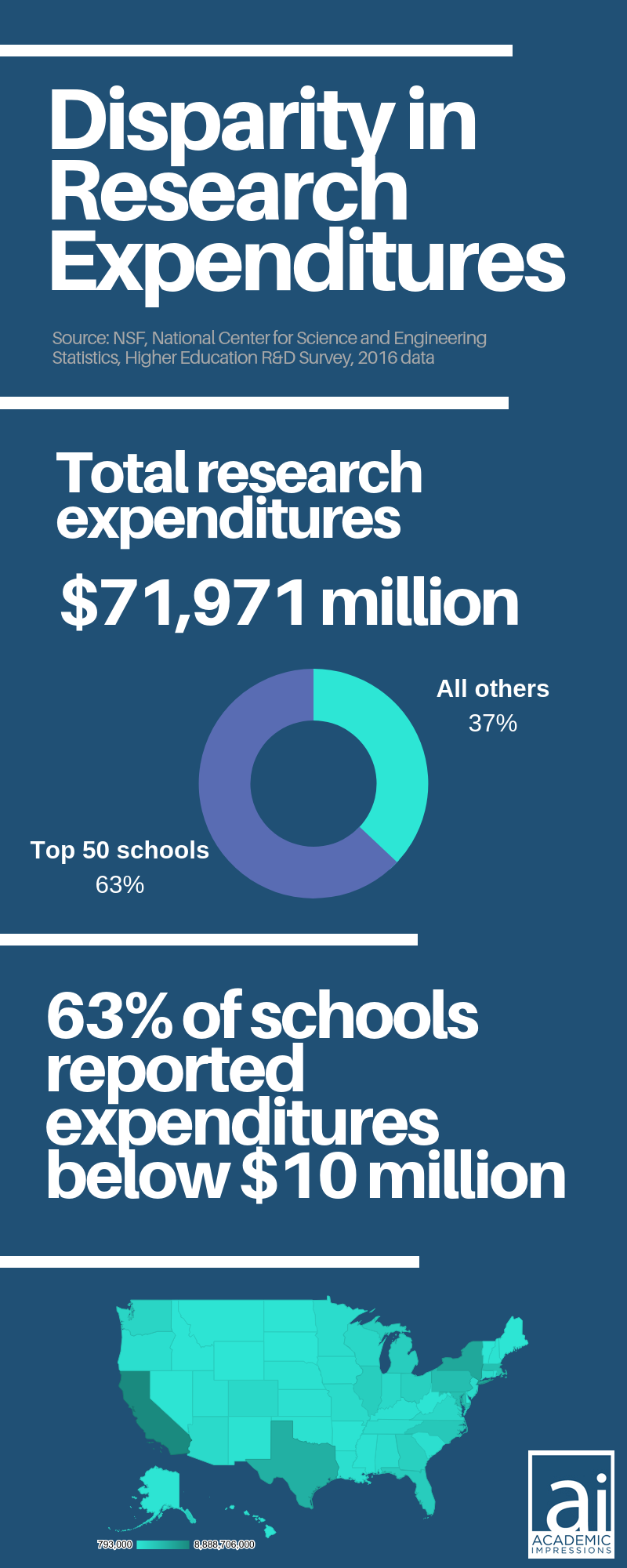
Research grants are increasingly competitive, and our analysis shows that just the top 50 colleges and universities account for nearly two thirds of research expenditures in the U.S.
by Sasha Egorova, Research Analyst, Academic Impressions
A Disparity in Research Grants
More higher ed institutions, including predominantly teaching universities, are facing a push to increase their research activity. Higher research expenditures mean prestige and contributions to economic development and innovation. However, breaking into this highly competitive space is a challenging endeavor. The current research environment in the US is as competitive as ever. Federal funding rates have been consistently declining over the past decades. For example, the NIH funding success rate has decreased from 31% in 1998 to 19% in 2017. The NSF funding rate has been hovering around 23% in the past couple of years.
The increase in competition has been caused and amplified by multiple factors, including flat federal research budgets. Other key factors, though, include:
- The increase in the number of applications. Since 1998, the number of NIH applications has more than doubled from 24,151 to 54,005 proposals.
- An uneven distribution of awards across universities. Based on the most recent NSF HERD data on research expenditures in higher ed, the top 50 research institutions currently receive more than 63% of all external research funding.
Taken all together, this means that 1 in 4 federal proposals gets funded, and the winning proposal is most likely to have come from a top 50 research university.

In Canada the competition for funding is not as fierce, with the government making continued investments in research. However, many institutions looking to break into the research space face internal challenges similar to their US counterparts. Institutions that want to gain ground in this competitive environment and grow their research expenditures have to find ways to engage their faculty in the effort, align research goals with faculty incentives, and build their internal research capacity and budgeting.
Sources
NIH. Research Project Grants: Competing applications, awards, and success rates. Accessed September 9, 2018. https://report.nih.gov/nihdatabook/index.aspx
NSF. Funding Rate by State and Organization FY 2008 to 2017. Accessed September 9, 2018. https://dellweb.bfa.nsf.gov/awdfr3/default.asp
NSF, National Center for Science and Engineering Statistics, Higher Education R&D Survey, 2016 data. Accessed September 9, 2018. https://ncsesdata.nsf.gov/herd/2016/
Image Credits:
Photo at the top by Louis Reed on Unsplash.
Infographic by Academic Impressions.
Want to Learn More? Check Out These Programs & Resources:
Complimentary Article | Implementing a Research Mission at Your Teaching-Intensive University
Recorded Webcast Bundle | Working at the University-Industry Interface: Effective Strategies for Active Researchers

